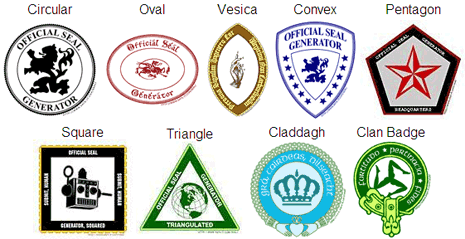

These "pendent" seal impressions dangled below the documents they authenticated, to which the attachment tag was sewn or otherwise attached (single-sided seals were treated in the same way). Most seals have always given a single impression on an essentially flat surface, but in medieval Europe two-sided seals with two matrices were often used by institutions or rulers (such as towns, bishops and kings) to make two-sided or fully three-dimensional impressions in wax, with a "tag", a piece of ribbon or strip of parchment, running through them. The process is essentially that of a mould. However engraved gems were often carved in relief, called cameo in this context, giving a "counter-relief" or intaglio impression when used as seals. This will not be the case if paper is embossed from behind, where the matrix and impression read the same way, and both matrix and impression are in relief. The design on the impression will reverse (be a mirror-image of) that of the matrix, which is especially important when script is included in the design, as it very often is.

In most traditional forms of dry seal the design on the seal matrix is in intaglio (cut below the flat surface) and therefore the design on the impressions made is in relief (raised above the surface). If the impression is made purely as a relief resulting from the greater pressure on the paper where the high parts of the matrix touch, the seal is known as a dry seal in other cases ink or another liquid or liquefied medium is used, in another color than the paper. The seal-making device is also referred to as the seal matrix or die the imprint it creates as the seal impression (or, more rarely, the sealing). The original purpose was to authenticate a document, or to prevent interference with a package or envelope by applying a seal which had to be broken to open the container (hence the modern English verb "to seal", which implies secure closing without an actual wax seal).
#Online official seal maker free#
If you also to have your legal documents completed or signed, you should check out our free document signing tool, SignWell.Present-day impression of a Late Bronze Age sealĪ seal is a device for making an impression in wax, clay, paper, or some other medium, including an embossment on paper, and is also the impression thus made. Once downloaded you may want to keep the file on your computer (or save in an online storage service like Dropbox). Signature images are meant to be added to documents or other places that allow embeddding of images. How do I use the signature image that I downloaded from here? Signatures by themselves don't make things legal, but they can help with identification and intent when it comes to legal contracts. This image can be embedded in documents, PDFs, and anything else that supports using images. When you enter or draw your name it gets converted into a downloadable signature image. We also have further reading for you if you want to know exactly what is an electronic signature.Ĭan I use this signature maker tool for legal documents?Ībsolutely. This typically involves a more complicated process involving private and public encryption keys.

Digital signatures are a type of electronic signature with encrypted information that helps verify the authenticity of messages and documents. This free tool helps you create a free downloadable electronic signature, which is the same as an online signature. What's the difference between an online signature, electronic signature, and digital signature? Everything that happens related to your signature is done in your browser and can't be seen (or accessed) by anyone else. No, for privacy reasons we do not keep any record of your signature data or your signature image on our servers. Do you keep a record of my signature on your system?


 0 kommentar(er)
0 kommentar(er)
